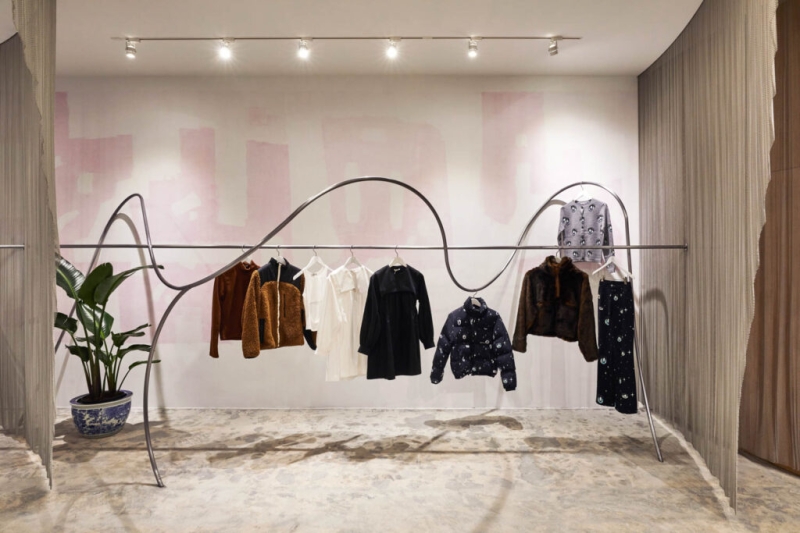Contents
- 1 How Almost Studio Crafts Projects Dedicated To Experimentation
- 1.1 Interior Design: Almost Studio was founded in 2018. Can you tell us about the studio’s earliest days and projects?
- 1.2 ID: Each of you previously worked at other people’s firms. What lessons from those roles inform your projects today?
- 1.3 ID: Your studio won the 2023 Love & Design competition, selected by Times Square Arts. Where did the idea for that work begin?
- 1.4 ID: Was it a meaningful experience to see it come to life, and are you actively looking for other competitions?
- 1.5 ID: You say that you expect your completed projects to change and grow over time. How does this approach inform your work and how have you seen this happen in past projects?
- 1.6 ID: Can you tell us a bit about your approach to materiality and shape in a retail environment like The Mandarin?
- 1.7 ID: It’s much different working with a client on their own residence. How does collaboration and concept play out on residential projects, for example the Bed-Stuy loft in Brooklyn?
- 1.8 ID: How did you get connected to fashion designer Sandy Liang?
- 1.9 ID: And what guided concept development for the Sandy Liang flagship?
- 1.10 ID: What are you currently working on and what type of work are you most interested in doing more of?
Sandy Liang Flagship Store, New York City, by Almost Studio. Photography by Jonathan Hökklo.
Established in Brooklyn several years ago by cofounders Anthony Gagliardi and Dorian Booth, Almost Studio is a design practice dedicated to experimentation and collaboration. Their projects include private residences, public installations, retail environments, and more. Each project is unique, and all are grounded in attention to material and form.
Gagliardi is an architect who earned a Master of Architecture at Yale University and studied at Ohio State University. Booth also earned a Master of Architecture at Yale University and, like Gagliardi, worked for other firms—including a stint leading design and technology development for Grain Surfboards—before the duo founded Almost Studio.
Interior Design speaks to them about early projects, showing art to residential clients during initial stages, their desire to do more work in the public realm, and more.
How Almost Studio Crafts Projects Dedicated To Experimentation
Interior Design: Almost Studio was founded in 2018. Can you tell us about the studio’s earliest days and projects?
Almost Studio: Our origin story actually starts in 2015, when we had a formative trip in graduate school. We lived with a larger group in Italy for one month and then continued together, driving throughout Spain, Portugal, and France. We realized our fundamentals overlap in thinking and interests—not just in the built aspects of architecture—but also in what we hoped architecture could achieve.
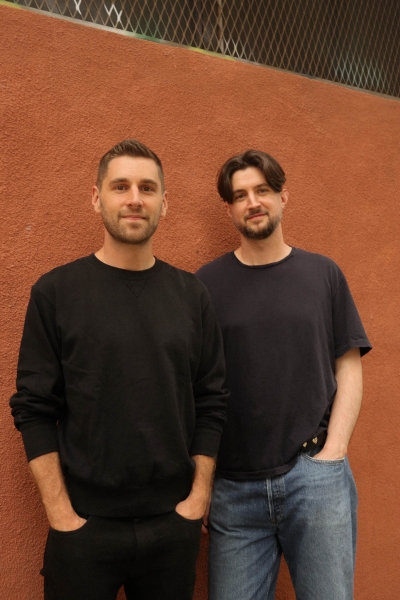
Anthony Gagliardi and Dorian Booth, co-founders of Almost Studio. Photography courtesy of Almost Studio.
Reflecting now, our earliest projects display embers of our beliefs that have only grown stronger over the years in our studio—that a project continually reveals unknown cultural, social, and spatial potential as time passes. It is always “almost.” When you accept that some of the most fulfilling successes of a project come from the uncontrollable surprises of how it grows with people and places, it is an entirely liberating concept. You then prioritize designing for future potentials rather than past or present prescriptions.
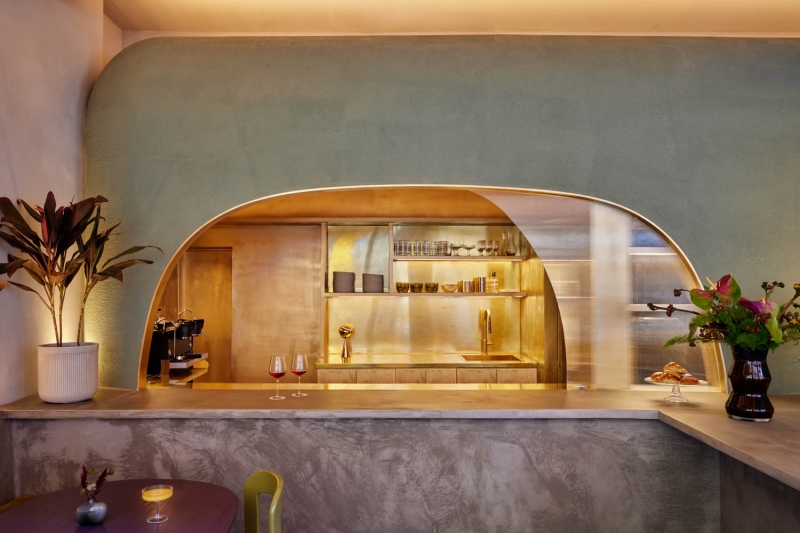
The Mandarin, New York City, by Almost Studio. Photography by Anna Morgowicz/Esto.
ID: Each of you previously worked at other people’s firms. What lessons from those roles inform your projects today?
AS: We are extremely fortunate and grateful for the experiences that we had prior to founding Almost Studio. Dorian worked in the offices of FreelandBuck, Joeb Moore & Partners, and LOT-EK, and Anthony worked and taught with Peter Eisenman and Steven Harris. At the expense of oversimplification, these mentors instilled that a project should be present at all scales—from an initial concept, to an urban plan, to private residence, to the structural drawings, to the millwork, to the reveal in the wall or floor. Architecture is at its best when it provokes, when it is built, and when it is detailed.
ID: Your studio won the 2023 Love & Design competition, selected by Times Square Arts. Where did the idea for that work begin?
AS: There were two key concepts that created the foundations to the project. The first was to design a “Code of Love” of similar breadth and regulatory authority as governmental “building codes.” What this means is that the formal basis of the entire project is driven by inclusivity—and the heart shapes themselves are generated by one square and two circles sized specifically in harmony with the Americans with Disabilities Act (ADA) written into all federal and state building codes. Second, the project tries to create a surrealist garden landscape in the infinite digital landscape of Times Square. For this, we referred to artists such as René Magritte and the novel Alice’s Adventures in Wonderland.
ID: Was it a meaningful experience to see it come to life, and are you actively looking for other competitions?
AS: This was a revelatory project for our studio because through the process, we discovered the depth of fulfillment and passion that we have for public work. We truly enjoy projects such as residences and spaces for private clients—and that will always be a critical part of our practice—but we also know that our studio is energized by having a balance and the specificities that adjoin both private and public work. Therefore, competitions, public art installations, and art exhibitions will continue to spark new ideas and ways of thinking about our private projects and vice versa.
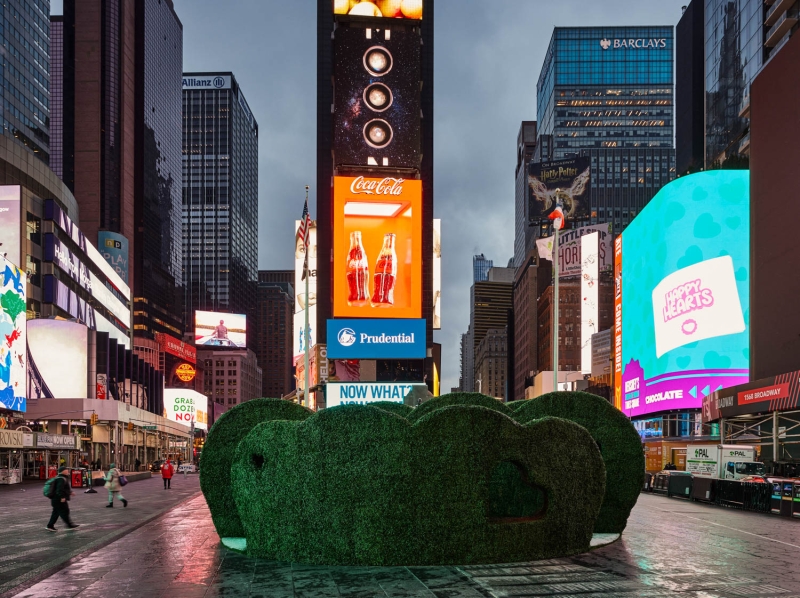
Times Square Theater, New York City, by Almost Studio. Photography by Jonathan Hökklo.
ID: You say that you expect your completed projects to change and grow over time. How does this approach inform your work and how have you seen this happen in past projects?
AS: For the Times Square Theater, we designed a stage—a platform for people to express themselves—and a daily live rose giveaway at 1:00PM. Over the short month of February, the project inspired and hosted many impromptu and unexpected events—including a Skrillex and Four Tet pop-up concert, two weddings, an engagement renewal ceremony for over one thousand people, a religious festival, and Season 15 of The Bachelor. Kids used it as a climbing gym, individuals hid solitary remembrances for loved ones, couples and families created memories together, and everyone was an actor in their own play for a moment.
And in the Myrtle Avenue Loft, a carved and carpeted niche was designed with carpet cut-outs to be a highly-specific dressing area for the client—that spot was eventually overtaken by their beloved family cat as a nap spot.
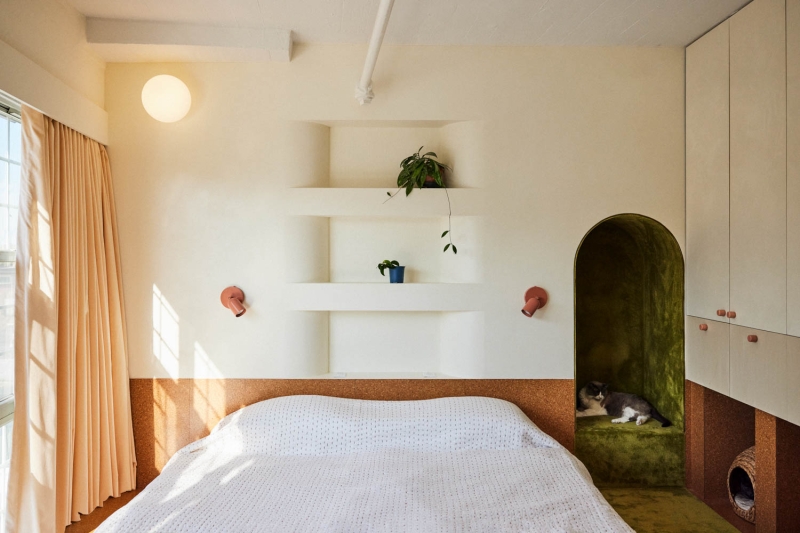
Myrtle Avenue Loft, New York City, by Almost Studio. Photography by Jonathan Hökklo.
ID: Can you tell us a bit about your approach to materiality and shape in a retail environment like The Mandarin?
AS: Form and material are fundamental to how we think about design projects. One example is The Mandarin café that we designed in New York City in Lower Manhattan.
When initiating the project, the clients’ primary hope was to create a community and a place of daily familiarity—of “rituals and regulars.” As a result, our design was inspired by early forms of community building, such as the Indigenous Hopewell Culture from Circleville, Ohio in 100 B.C. In this case, two simple geometries—a circle and a square—are the essential organizational devices to create community and structure rituals. The café references this formal strategy in the space, the material, and the lighting. The square creates entry and holds a communal table and the café counter, while the circle is a custom banquet seating area positioning individual tables around the perimeter and encouraging spontaneous conversations and the feeling of a collective. Each form also projects and rotates down from the ceiling, allowing for a soft glow throughout the space and inspired by the artist James Turrell.
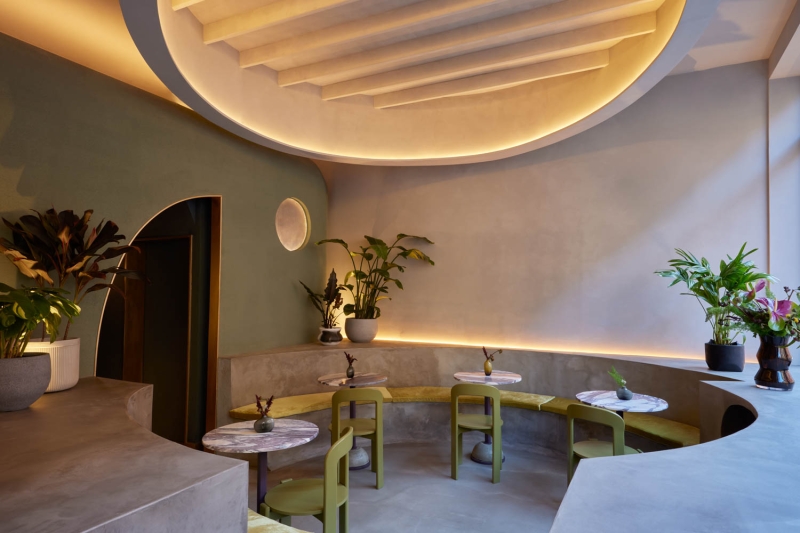
The Mandarin, New York City, by Almost Studio. Photography by Anna Morgowicz/Esto.
ID: It’s much different working with a client on their own residence. How does collaboration and concept play out on residential projects, for example the Bed-Stuy loft in Brooklyn?
AS: Our process—no matter what type of project—begins with art. In our first design meetings with clients, we typically present several artists and works that we feel align with the clients’ vision. Art provides an open-ended, inclusive, and less intimidating spark to learn a lot about what someone likes, and, more importantly, doesn’t like.
When a client sees an architectural reference of an apartment when starting the design of their own apartment—it is too one-to-one and too specific. You might get comments such as “I like that wall texture,” or “This kitchen island is great,” which doesn’t leave much room for interpretation or exploration. However, when discussing art with clients, we are able to better understand their proclivities to certain formal relationships, color palettes, and hierarchies of space that have an expanded means of interpretation. For example in the Myrtle Avenue Loft, we initially presented works from Christo, Josef Albers, and Kazimir Malevich to the clients.
ID: How did you get connected to fashion designer Sandy Liang?
AS: This is a little more of a straightforward answer—Dorian is married to Sandy Liang! We have been inspired by her work from the beginning and continue to learn from her throughout our own process.
ID: And what guided concept development for the Sandy Liang flagship?
AS: For this store, we drew from a few key elements throughout the design process. One was Sandy’s connection to the neighborhood, growing up there and having continued deep family ties to the area. The previous tenant of the space was a laundromat, an integral part of any local community in New York City. In the hopes of continuing a small part of that neighborhood lineage—that shared and collective inheritance—the most prominent formal feature of the store pays homage to the spiraling laundromat conveyor belts that wistfully brought clothing into closer reach.
Another key component of the project occurred partway through construction, during one of our studio’s typical site visits. While walking through the space, we noticed many hand-drawn, penciled notes from the construction workers on the patchy pink and white walls. We ended up reading through these notes as if they were a story—a story of how this retail store came to be, by the people who created it. After this, it was impossible to cover this story up with conventional, generic drywall. These notes, the pink and white patchy wall, and the story of the people and the place that created it became as much a part of the store as the clothing it was meant to display.
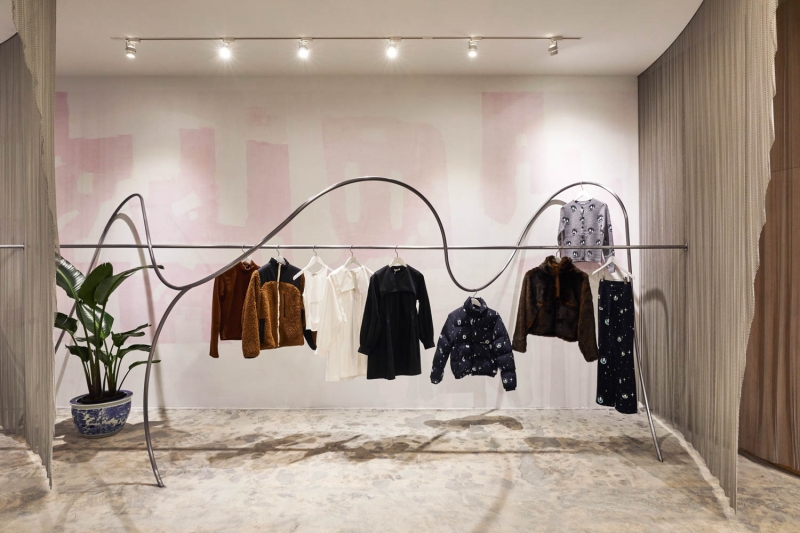
Sandy Liang Flagship Store, New York City, by Almost Studio. Photography by Jonathan Hökklo.
ID: What are you currently working on and what type of work are you most interested in doing more of?
AS: We are excited about a number of current projects happening in the studio! We are designing an apartment in Brooklyn Heights that is based on calligraphy and working on the full renovation of a house and gardens in upstate New York in the shape of an octagon (which was originally part of a “kit” of houses that you could purchase online and in catalogues).
We were also invited to showcase work in the Time Space Existence exhibition at the 2025 Venice Architecture Biennale. It is a research project in collaboration with an incredible artist and friend Nanette Carter, which addresses the exhibition’s theme of “Repair, Regenerate, and Reuse.” Our specific project is referencing Nanette’s stunning work to propose new speculative suburban developments in an area just outside of Phoenix, Arizona. The work will be on display in Palazzo Mora in Venice from May to November of this year.
And our studio intends to continue scaling up as it relates to the size of projects, the amount of public interaction, and the types of programs. We hope to bring people’s visions for their homes to life in an artistic way—while also growing our relationships with companies and organizations. We hope we can continue to be surprised by the lives our projects take on over time in the public sphere as libraries, museums, senior care centers, art galleries, and many other collaborations. Just as our projects continue to grow over time, we hope our studio, our processes, and our relationships do as well—in other words we are Almost Studio.

Sandy Liang Flagship Store, New York City, by Almost Studio. Photography by Jonathan Hökklo.

